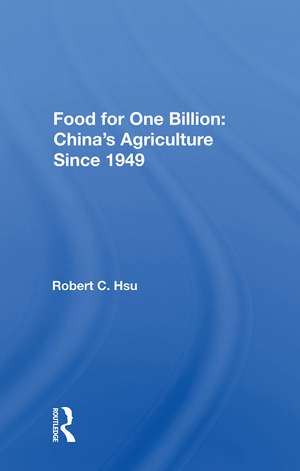Food For One Billion: China's Agriculture Since 1949
Autor Robert C. Hsuen Limba Engleză Hardback – 7 iun 2019
Preț: 764.20 lei
Preț vechi: 1027.40 lei
-26% Nou
Puncte Express: 1146
Preț estimativ în valută:
146.26€ • 152.11$ • 122.39£
146.26€ • 152.11$ • 122.39£
Carte tipărită la comandă
Livrare economică 15-29 martie
Preluare comenzi: 021 569.72.76
Specificații
ISBN-13: 9780367018405
ISBN-10: 0367018403
Pagini: 172
Dimensiuni: 146 x 229 mm
Greutate: 0.45 kg
Ediția:1
Editura: Taylor & Francis
Colecția Routledge
Locul publicării:Oxford, United Kingdom
ISBN-10: 0367018403
Pagini: 172
Dimensiuni: 146 x 229 mm
Greutate: 0.45 kg
Ediția:1
Editura: Taylor & Francis
Colecția Routledge
Locul publicării:Oxford, United Kingdom
Cuprins
Introduction -- The Natural Environment -- Historical Background -- Agriculture in China's Development Strategies -- Technological Changes: Fertilization, Water Control, and Plant Breeding -- Technological Changes: Mechanization, Rural Energy, and Plant Protection -- Financing Agricultural Development -- Summary, Evaluation, and Conclusions
Descriere
This book examines the agricultural policies and programs adopted by the Chinese leadership since 1949 and analyzes the role of agriculture in China's changing development strategies. Dr. Hsu gives particular attention to the measures intended to improve agricultural technology and to the sources of funds for agricultural investment. He concludes that, although the collective system has been effective in mobilizing China's rural resources for agricultural development and in promoting progress in labor-intensive agricultural technology, periodic extreme leftist policies and interference by rural party cadres have caused various kinds of inefficiency, offsetting the advantages gained from collective farming. This is the first book to systematically analyze the ways in which China's agricultural development is being financed. By critically examining the level and nature of state resources allocated to agriculture, the author challenges the view that China has pursued an agriculture-first strategy of economic development since the early 1960s.
